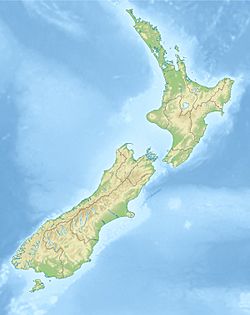1942 Wairarapa earthquakes facts for kids
| UTC time | |
|---|---|
| 1942-06-24 11:16:30 | |
| 1942-08-01 12:34:06 | |
| ISC event | |
| 900349 | |
| 900404 | |
| USGS-ANSS | |
| ComCat | |
| ComCat | |
| Local date | 24 June 1942 2 August 1942 |
| Local time | |
| 23:16 | |
| 12:34 | |
| Magnitude | |
| 6.9–7.2 Mw | |
| 6.8 Mw | |
| Depth | 12 km 35 km |
| Epicenter | 40°58′S 175°41′E / 40.96°S 175.69°E |
| Areas affected | New Zealand, North Island |
| Casualties | one death |
In 1942, two big earthquakes hit the lower North Island of New Zealand. They happened on June 24th and August 2nd. Both quakes were strong and not very deep. Their starting points, called epicentres, were close to each other, east of Masterton in the Wairarapa region.
The June earthquake was sometimes called the Masterton earthquake. Both quakes caused a lot of damage over a wide area. This included places like Dannevirke, Eketahuna, Whanganui, Otaki, and Wellington. Sadly, one person died in Wellington during the June 24th quake.
The August earthquake is seen as an aftershock of the June one. An aftershock is a smaller earthquake that happens after a larger one in the same area. Both big earthquakes were also preceded by smaller foreshocks. A foreshock is a small earthquake that happens before a larger one. The August quake was a bit deeper than the first one. There were also more large aftershocks in December 1942 and February 1943.
Contents
The Wairarapa Region and Earthquakes
The Wairarapa region has had many large earthquakes before. A very big one, the 1855 Wairarapa earthquake, happened there in 1855. Another strong quake, the 1934 Pahiatua earthquake, hit the northern Wairarapa area in 1934.
The 1855 earthquake happened along the Wairarapa Fault. A fault is a crack in the Earth's crust where rocks move past each other. This fault is part of a bigger system of faults in the North Island.
The June 24, 1942 Earthquake
At 11:16 pm on June 24th, a strong earthquake shook a large part of the lower North Island. It was felt from Eketahuna to Masterton, Featherston, and Wellington. People even felt it as far away as Auckland and near Dunedin.
This main earthquake had a magnitude of about 7.2. Its epicentre was near Masterton, and it was about 12 kilometers deep. The shaking lasted for over a minute. A smaller foreshock happened three hours earlier, at 8:15 pm.
Many buildings in Masterton were damaged. The mayor, Thomas Jordan, declared a state of emergency. Soldiers were sent to patrol the town. There was also a lot of damage in Palmerston North.
In Wellington, about 20,000 chimneys fell down. A 70-year-old retired chemist, Hedley Victor Evens, died in Kelburn. He was killed by coal gas from a broken pipe. Some decorative parts of buildings in downtown Wellington were also damaged. However, some had already been removed after the 1931 Hawke's Bay earthquake. The city engineer thought the damage was less severe because the quake ended quickly.
The August 2, 1942 Earthquake
Another strong earthquake hit the area on August 2nd at 12:34 am. A foreshock happened on the evening of August 1st. This second quake had a magnitude of about 6.8. It was slightly less strong than the first one.
The epicentre of this quake was about 40 kilometers deep. The Wairarapa region, except for Eketahuna, did not suffer as badly this time. However, in Masterton, the damage from June got even worse.
After the August 2nd quake, a third severe aftershock happened on December 2nd. About 600 aftershocks were recorded by the end of that year.
Damage Caused by the Earthquakes
Repairs from the first earthquake were not finished when the second one hit. The cement used for some repairs had not fully dried. Some buildings that were already weak from the June quake suffered more damage. It was sometimes hard to tell if the new damage was from the first or second quake.
In Masterton, many buildings were badly damaged by the first quake. These included the fire station, the Bank of New Zealand, several shops, and St Matthews Church. The church was later blown up by the Army because it was too damaged. The road bridge over the Waiohine River on State Highway 2 sank badly and was closed. After the second quake, part of Masterton's WFCA building collapsed.
In Wellington, the first quake knocked down about 20,000 chimneys. In August, there was serious damage near the Willis Street – Manners Street area. Three buildings were badly hit: Charles Begg's music shop, the Duke of Edinburgh Hotel, and the Regent Hotel. Manners Street, between Willis and Cuba Streets, had to be closed for several months.
A nurse at Wellington Hospital was lucky to be working a night shift. A chimney crashed onto her bed, but she was not in it. At the Porirua mental hospital, 800 patients had to be moved to other hospitals.
Overall Cost and Impact
The damage from these two earthquakes cost more than £2 million (pounds). This was a huge amount of money for New Zealand, especially since the country was in the middle of World War II. In Masterton, you could still see damage from the quakes even 12 years later.
One important result of these earthquakes was the government setting up the Earthquake Commission in 1945. This commission helps people with earthquake insurance and recovery.



